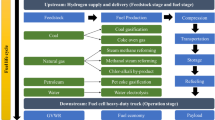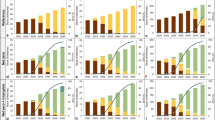Abstract
Purpose
Decarbonizing the heavy-duty truck (HDT) sector is a climate imperative but also a challenging element to meet China’s carbon reduction commitment. Various technological and non-technological measures are emerging. However, a comprehensive understanding is still lacking regarding the extent to which these measures can decarbonize the HDT fleet. This study aims to provide a systematic assessment of near and long-term strategies toward decarbonizing the road freight sector in China from a well-to-wheels (WTW) life cycle perspective.
Methods
A fleet-based dynamic model is developed to estimate the prospective greenhouse gas (GHG) emissions of China’s HDT sector from 2020 to 2050. The case study considers the overall WTW life cycle GHG emissions including the fuel and energy production, distribution, and the use for vehicle operation. Relative to a base case scenario, four mitigation options are investigated: improvements in freight logistics, internal combustion engine vehicle (ICEV) efficiency improvements, adoption of advanced hybrid technology, and the use of alternative fuel types. The study quantifies the potential emission reduction and energy demand by deploying these measures synergistically through 2050. The implications of upstream fuel production pathways to the fleet GHG emissions are examined.
Results and discussion
The annual GHG emissions of China’s HDT fleet are projected to nearly double from 2020 to 2050 if no abatement technologies are implemented. Cumulative deployments of considered measures will enable the net GHG emissions to peak in 2029 and result in more than 60% emission reduction in 2050. Improving conventional vehicles through ICEV efficiency improvement and hybridization, complemented by improved logistics operations, presents important near-term opportunities to moderate the rise in GHG emissions. Meanwhile, the growing penetrations of battery electric and hydrogen fuel cell trucks, coupled with sufficient access to lower-carbon sources, could facilitate deeper reductions in emissions in the longer term. Furthermore, low carbon synthetic fuel offers an opportunity to accelerate the decarbonization of older trucks still existing within the fleet.
Conclusions
There is no silver bullet to decarbonize the HDTs, whereby, on its own, each measure is inadequate to fully mitigate emissions from China’s growing freight sector. A broad mix of energy, powertrain technologies, and logistical solutions is needed to support an orderly low carbon transition for China’s HDT sector. This will require a more holistic regulatory framework, such as life cycle assessment approaches, to encourage innovations of all technologies for a sustainable freight transport future.











Similar content being viewed by others
Data availability
Data generated or analyzed during this study are described in this article and its supplementary information file. The fleet model, with raw data, is available from the corresponding author upon reasonable request.
References
BNEF (2019) Electric vehicle outlook 2019, s.l.: Bloombergy NEF
CATARC (2021) Annual report on energy-saving and new energy vehicle in China (in Chinese). Post & Telecom Press, Beijing, China
CEC (2020) Annual compilation of statistics of the power industry 2020 (in Chinese), Beijing, China: China Electricity Council
CHA (2019) White paper on China hydrogen and fuel cell industry, Weifang, Shangdong Province, China: China Hydrogen Alliance
CHA (2020) China hydrogen energy and fuel cell industry development report 2020 (in Chinese). People’s Daily Press, Beijing, China
China EV100 (2020) Report of China hydrogen industry 2020 (in Chinese), Beijing, China: China EV100
Christensen A, Petrenko C (2017) CO2-based synthetic fuel: assessment of potential European capacity and environmental performance, s.l.: The International Council on Clean Transporation
de Blas I, Mediavilla M, Capellan-Perez I, Duce C (2020) The limits of transport decarbonization under the current growth paradigm. Energ Strat Rev 32:100543
Delgado O, Li H (2017) Market analysis and fuel efficiency technology potential of heavy-duty vehicles in China, s.l.: The International Council on Clean Transporation
European Commission (2018) Renewable energy—recast to 2030 (RED II), s.l.: European Commission
Fong SC, Tao Z, Jinghai L, Chunli B (2017) Liquid Sunshine: opportunites and pathways to a green future for all—a viable energy strategy for China (Chinese Academy of Sciences Report), s.l.: s.n
Gan Y et al (2019) Projecting stock and energy consumption of trucks in China through 2050. s.n, Washington DC
GEIDCO (2020) China “14th-five” electricity development pathway study (in Chinese), Beijing, China: Global Energy Interconnection Development and Cooperation Organization
Hao H et al (2018a) Biofuel for vehicle use in China: current status, future potential and policy implications. Renew Sustain Energy Rev 82:645–653
Hao H, Mu Z, Liu Z, Zhao F (2018b) Abating transport GHG emissions by hydrogen fuel cell vehicles: chances for the developing world. Front Energy 12:466–480
Hao H, Wang H, Ouyang M, Cheng F (2011) Vehicle survival patterns in China. Sci China Technol Sci 54:625–629
He T et al (2016) Hydrogen carriers. Nat Rev Mater 1:16059
He W et al (2020) Analysis of real-world fuel consumption characteristics of heavy-duty commercial diesel vehicle based on OBD method. IOP Conf Ser Mater Sci Eng 774:012137
Huo H et al (2012) Vehicle-use intensity in China: current status and future trend. Energy Policy 43:6–16
Huo H, Wang M, Johnson L, He D (2007) Projection of Chinese motor vehicle growth, oil demand, and CO2 emissions through 2050. Transp Res Rec 2038(1):69–77
Hydrogen Council (2021) Hydrogen decarbonization pathways—a life-cycle assessment, s.l.: Hydrogen Council
IEA (2017) The future of trucks—implications for energy and the enviroment (second edition), s.l.: International Energy Agency
IEA (2021) An energy sector roadmap to carbon neutrality in China, Paris, France: International Energy Agency
IPCC (2014) Climate change 2014: synthesis report. Contribution of Working Groups I, II and III to the Fifth assessment report of the intergovernmental panel on climate change. Intergovernmental Panel on Climate Change
Li G et al (2020) Life cycle energy consumption and GHG emissions of biomass-to-hydrogen process in comparison with coal-to-hydrogen process. Energy 191:116588
Li J (2020) Technology roadmap for energy saving and new energy vehicles 2.0. Shanghai, s.n
Li J, Cheng W (2020) Comparative life cycle energy consumption, carbon emissions and economic costs of hydrogen production from coke oven gas and coal gasification. Int J Hydrogen Energy 45(51):27979–27993
Liu CM, Sandhu NK, McCoy ST, Bergerson JA (2020) A life cycle assessment of greenhouse gas emissions from direct air capture and fisher-tropsh fuel production. Sustainable Energy Fuels 4:3129–3142
Liu X, Elgowainy A, Vijayagopal R, Wang M (2021) Well-to-wheels analysis of zero-emission plug-in battery electric vehicle technology for medium- and heavy-duty trucks. Environ Sci Technol 55(1):538–546
Lu Z et al (2018) China vehicle fleet model: estimation of vehicle stocks, usage, emissions, and energy use-model description, technical documentation, and user guide, Argonne, IL, United States: Argonne National Lab
Mallapaty S (2020) How China could be carbon neutral by mid-century. Nature 586:482–483
Mao S, Ragon P-L, Rodriguez F (2021) The evolution of commercial vehicles in China: a retrospective evaluation of fuel consumption standards and recommendations for the future, s.l.: The International Council on Clean Transportation
MEE (2018) The second biennial climate change report of the People's Republic of China, China: National Communication on Climate Change
Milovanoff A, Posen ID, MacLean HL (2020) Electrification of light-duty vehicle fleet mitigation targets. Nat Clim Chang 10:1102–1107
MOC (2013) Compulsory scrappage standards for motor vehicles (in Chinese). Ministry of Commerce of the People’s Republic of China, Beijing, China
Nasri MI, Bektas T, Laporte G (2018) Route and speed optimization for autonomous trucks. Comput Oper Res 100:89–101
National Bureau of Statistics PRC (2021) China statistical yearbook 2021. China Statistics Press, Beijing, China
Peters GP et al (2017) Key indicators to track current progress and future ambition of the Paris Agreement. Nat Clim Chang 7:118–122
Ricardo Energy & Environment (2020) Determining the environmental impacts of conventional and alternatively fuelled vehicles through LCA, s.l.: report for the European Commission, DG Clime Action
Ricardo-AEA (2015) Light-weighting as a means of improving heavy-duty vehicles: energy efficiency and overall CO2 emissions, s.l.: report for European Commission DG Climate Action
Rodriguez F, Muncrief R, Delgado O, Baldino C (2017) Market penetration of fuel-efficiency technologies for heavy-duty vehicles in the European Union, the United States, and China, s.l.: the International Council on Clean Transporation
Schroten A, Warringa G (2012) Marginal abatement cost curves for heavy duty vehicles: background report, Delft, Netherlands: CE Delft
Scora G, Boriboonsomsin K, Barth M (2015) Value of eco-friendly route choice for heavy-duty trucks. Res Transp Econ 52:3–14
Soler A (2020) Role of e-fuels in the European transport system. Literature review. Report no. 14/19, Brussels: CONCAWE
Sphere (2020) GaBi Version 9.2—LCA software and 2020 Life Cycle Inventory Databases, s.l.: Sphera (formerly thinkstep)
Sripad S, Viswanathan V (2017) Performance metrics required of next generation batteries to make a practical electric semi truck. ACS Energy Lett 2(7):1669–1673
Sun X et al (2019) Life cycle energy use and greenhouse gas emission of lightweight vehicle—a body-in-white design. J Clean Prod 220:1–8
The Royal Society (2019) Sustainable synthetic carbon based fuels for transport—policy briefing. The Royal Society, s.l.
Ueckerdt F et al (2021) Potential and risks of hydrogen-based e-fuels in climate change mitigation. Nat Clim Chang 11:384–393
UN Affairs (2021) UN News. [Online] Available at: https://news.un.org/en/story/2021/09/1100642. Accessed 8 Dec 2021
Vaughan A (2021) China’s new climate plan promises to peak CO2 emissions before 2030. NewScientist, 28 October
Wang K et al (2022) Life-cycle CO2 mitigation of China’s class-8 heavy-duty trucks requires hybrid strategies. One Earth 5(6):709–723
Wolff S et al (2020) Scalable life-cycle inventory for heavy-duty vehicle production. Sustainability 12:5396
Wu Z et al (2018) Life cycle greenhouse gas emission reduction potential of battery electric vehicle. J Clean Prod 190:462–470
Yugo M, Soler A (2019) A look into the role of e-fuels in the transport system in Europe (2030–2050) (literature review), s.l.: Concawe
Zang G et al (2021) Life cycle analysis of electrofuels: Fischer-Tropsch fuel production from hydrogen and corn ethanol byproduct CO2. Environ Sci Technol 55(6):3888–3897
Zheng J et al (2019) Survival rate of China passenger vehicles: a data-driven approach. Energy Policy 129:587–597
Acknowledgements
Views expressed in this work are those of the authors alone.
Funding
This work was financially supported by Saudi Aramco Technologies Company and used resources and data from China Automotive Technology and Research Center Co., Ltd.
Author information
Authors and Affiliations
Corresponding author
Ethics declarations
Conflict of interest
The authors declare no competing interests.
Additional information
Communicated by Vanessa Bach
Publisher's Note
Springer Nature remains neutral with regard to jurisdictional claims in published maps and institutional affiliations.
Supplementary Information
Below is the link to the electronic supplementary material.
Rights and permissions
Springer Nature or its licensor (e.g. a society or other partner) holds exclusive rights to this article under a publishing agreement with the author(s) or other rightsholder(s); author self-archiving of the accepted manuscript version of this article is solely governed by the terms of such publishing agreement and applicable law.
About this article
Cite this article
Xue, X., Li, J., Sun, X. et al. Assessing decarbonization pathways of China’s heavy-duty trucks in a well-to-wheels perspective. Int J Life Cycle Assess 28, 862–876 (2023). https://doi.org/10.1007/s11367-022-02124-y
Received:
Accepted:
Published:
Issue Date:
DOI: https://doi.org/10.1007/s11367-022-02124-y




